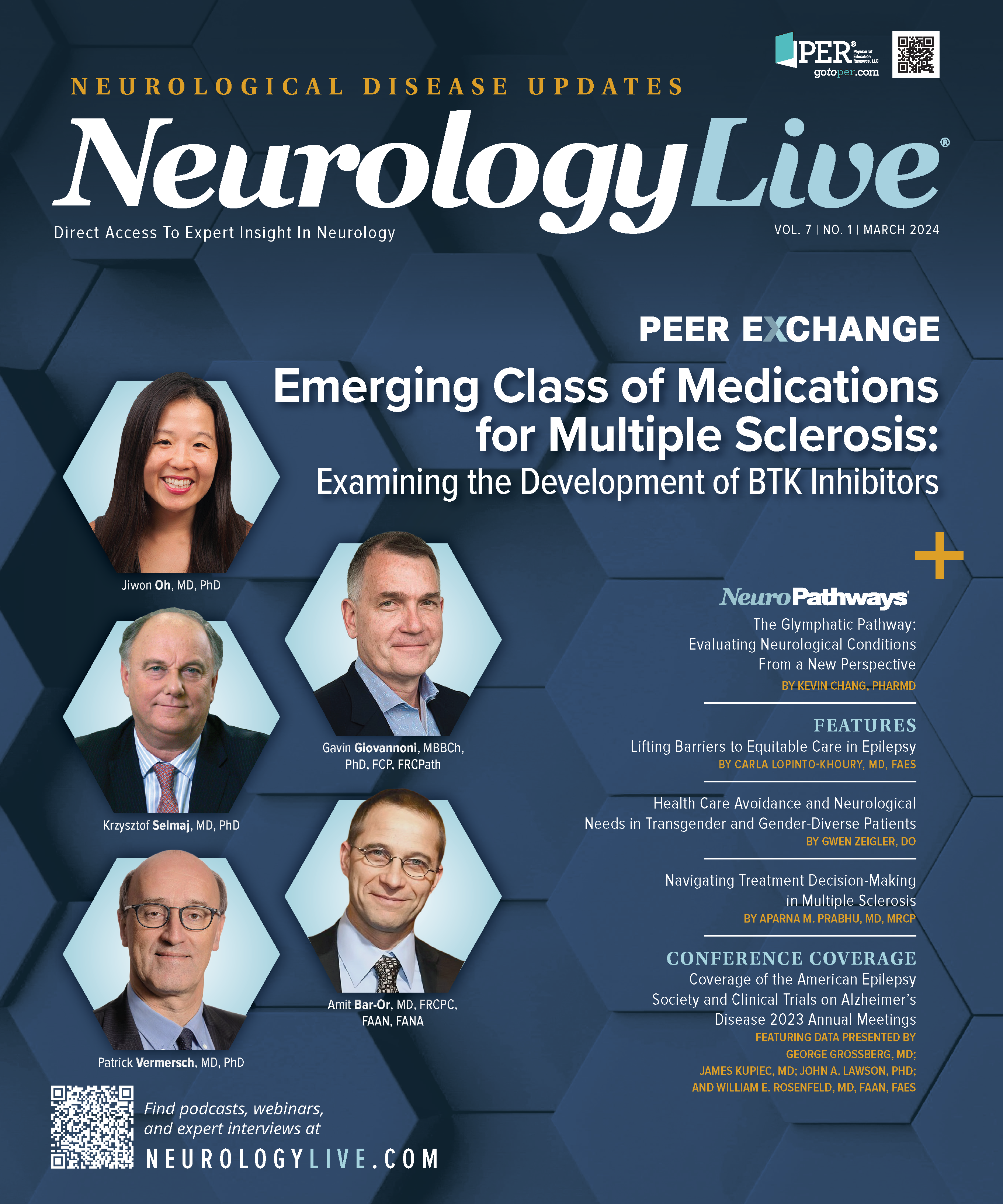Publication
Article
NeurologyLive
Lifting Barriers to Equitable Care in Epilepsy
Author(s):
Four neurologists treating patients with epilepsy share their experience in and out of the clinic tackling issues of access for their patients.
Carla LoPinto-Khoury, MD, FAES

DIAGNOSTIC METHODS AND TREATMENTS for epilepsy are improving at an incredible rate. In the past decade, the commercially available genetic epilepsy panels have expanded from 10 to more than 300 genes—double the number available in 2020. The list of available epilepsy drugs has grown to 24, and ever-increasing literature on long-term effects of older generation antiseizure medications has convinced a generation of prescribers to switch to newer-generation antiseizure medications with lower risk of cardiovascular events, osteoporosis, and other chronic effects. Three new surgical therapies—laser interstitial thermal therapy, responsive neurostimulation, and deep brain stimulation—have become important options for patients with medically refractory disease.
Although the epilepsy field has progress to celebrate, we have much work to do when it comes to lifting the barriers that keep all our patients from getting advanced equitable care.1,2 I interviewed 4 neurologists about the barriers that their patients face and how they are working to improve disparities in epilepsy care.
Rural and Native Populations
Michael Stitzer, MD, has served as the first chief clinical consultant at the Indian Health Service within the US Department of Health and Human Services since 2017 and has been an adjunct instructor in neurology at Mayo Clinic Arizona in Phoenix since 2021, providing a rural neurology rotation. He is also a general neurologist for the Winslow Indian Health Care Center, which is a tribally run unit within the Navajo Area, spanning portions of Arizona, New Mexico, and Utah. Including Navajo, there are 574 federally recognized Native tribes, each with their own set of cultures, values, traditions, language, and government. Stitzer’s tribe, Estom Yumeka Maidu, is different than Navajo and Hopi, which is another tribe he cares for frequently. He has educated himself on providing culturally appropriate care with formal training and lunch sessions offered by Navajo staff at his center. Although telehealth has improved access to care and reduced missed visits for his patients with epilepsy, he stresses the importance of the Public Health Nursing Department, which can make house calls in cases of patients with little to no phone or mail services or access to transportation. Since 2012, access to neurology care in his region of the Indian Health Service improved because there are now 4 providers, whereas before there were none. Most other areas still do not have any neurologists working directly for the Indian Health Service.
When Stitzer’s patients have uncontrolled epilepsy, he must refer them to epilepsy centers in urban areas. “My patients will typically have to travel 600 to 1000 miles round trip for this care. [Although] nonemergent medical transport services can sometime ease a portion of the travel burden, there can be challenges with the cost of travel and lodging, road conditions, etc…. Rural patients of any background face similar challenges across the country,” Stitzer said.
Another hurdle is patients with epilepsy and intellectual disability who are older and without a current legal guardian to make medical decisions. Staffing shortages in his region have led to closure of a pharmacy program at his clinic that helped with medication adherence for his patients with epilepsy. Notwithstanding the difficulty in his patients making it to an epilepsy center, Stitzer reports that his patients with epilepsy who have had surgery and return to his clinic have done well.

Genetic Testing Access
Pamela Pojomovsky McDonnell, MD, is a clinical assistant professor at Children’s Hospital of Philadelphia (CHOP) in Pennsylvania, where she is also the medical codirector of global medicine; part of the Epilepsy Neurogenetics Initiative; and the Diversity, Equity, and Inclusion (DEI) cochair for the Division of Neurology at CHOP. Although most cases of epilepsy remain undiagnosed today, she believes that with the tremendous advances in genetic diagnostics, this will improve. “The field of neurogenetics is a great place to make a niche; you can see phenotypic variants that have not been initially reported,” she said.
Many neurologists are not aware that there is free genetic testing offered to children younger than 8 years, which is something Pojomovsky McDonnell said can be done fairly quick. “You can see a patient in your clinic, swab them, and have the results back within 3 weeks,” she said. Genetic precision therapy is being used with drugs such as cannabidiol, stiripentol, and the ketogenic diet, and repurposing of older pharmaceuticals such as 4-phenylbutyrate. Antisense oligonucleotides are also in trial for genetic variants, including SCN1A. These therapies mean that the use of genetic testing is becoming paramount.3
Pojomovsky McDonnell sees disparities in access to genetic epilepsy diagnosis and knowledgeable care both locally and globally. The COVID-19 pandemic exacerbated many of the obstacles faced by her local patients who were non-English speakers. She noticed that telemedicine portal instructions were being provided only in English at the start of the pandemic. For her patients aged 8 years and older, genetic testing can run between $250 to $1000 out of pocket depending on income. This is possible if you have access to a clinic that has resources to work with labs to access these prices, but this can still be a barrier for many patients. Ethnic minorities can run a risk of having variants that are not typically found in the Genome Aggregation Database (a large population database known colloquially as gnomAD) and lead to a misdiagnosis in some cases. There are ongoing efforts to improve the genetic makeup of these large population databases to be more inclusive.
Globally, access to any epilepsy care is hard to get. Pojomovsky McDonnell has lectured to pediatricians and neurologists across Latin America regarding basic epilepsy care in children and surgical epilepsy care. Patients from around the world come to her, but she knows those are the fortunate few. Even affluent families in Latin America suffer from limited pharmaceutical options, and genetic labs may not have the resources to properly run exome tests on both the proband and parents, leading to false-positive results. She currently works with her genetic counselors to facilitate access to affordable genetic testing to those patients who come to see her in the United States.
Unconscious Bias
When Camilo Gutierrez, MD, associate professor of neurology and vice chair for DEI in the Department of Neurology at the University of Maryland in Baltimore, coauthored his 2018 paper, “FACETS of Health Disparities in Epilepsy Surgery and Gaps That Need to be Addressed,” in Neurology Clinical Practice,4 the concept of physician bias was still controversial. Social determinants of health seemed to be out of the purview of physicians in the past. Now, he can speak more freely about how to address unconscious biases that can lead to poor communication and trust. “It turns out that we have a lot of control,” he said, regarding how neurologists speak to their patients. He advocates for culturally competent training for physicians that includes information about barriers to care in the communities they serve, including how to understand and address barriers such as how patients obtain their medications, food, and transportation. Physicians should tailor counseling to their patients in practical ways; for instance, on how to reach the clinic for refills. Nonphysician health care workers can be invaluable when implementing equitable care. He points to the proven benefit of clinical pharmacists in educating patients on diabetes medications, and he suggests that epilepsy centers borrow from this by adding pharmacists to their teams. Community health workers, who are individuals from the community trained to work alongside social workers to help patients navigate the health care system, are another resource that should be studied.
Gutierrez has found that addressing the multiple components of barriers to equitable care (fear of treatment, access to care, communication barriers, education, trust between patient and physician, and social support) requires time and dedication. Each patient is unique, and the intersectionality of race, gender, and socioeconomic and geographic factors can be best understood by careful consideration by their treating team. For instance, treating epilepsy in transgender persons must consider hormonal interactions with antiseizure medications. “Each time you address one of these factors, you move the needle toward better care for that individual,” Gutierrez said. The benefits to health care systems are clear when patients use emergency departments less for their epilepsy care, which is why health care systems and government policymakers should invest into programs that support health equity.
Although we must be quick to advocate for progress in our profession and our institutions, we also need patience. As Gutierrez said, “Health equity will not be achieved in 1 day.” It is our job as neurologists to vigilantly study the barriers to equitable epilepsy care and remove them in practice, 1 patient and 1 day at a time.
When Tiffany Fisher, MD, PhD, moved from her epilepsy fellowship at University of North Carolina to Penn State Health Milton S. Hershey Medical Center as the current chief of the Division of Epilepsy, she noticed that the demographics of those who received advanced care differed substantially from the surrounding population. This prompted her epidemiological research using TriNetX data, as prior research demonstrated that Black individuals made up 15.9% of the epilepsy population but only 8% of those implanted with vagus nerve stimulators.5 “The risk of sudden unexpected death in epilepsy [known as SUDEP] is highest in Black men; we must do something different,” Fisher said. Her first step is education; she might be the first neurologist who has mentioned devices as an option to surgery. Unfortunately, their prior neurologists might have been convinced that they would not change their mind about epilepsy surgery. Although it takes time to build trust with her patients, and repetition of the numbers at each visit, Fisher’s patients will often conclude that epilepsy surgery is not as risky as they thought it would be.
Fisher’s role in her department as DEI associate vice chair allows her to collaborate with other faculty at Hershey who are passionate about equitable care. They understand that “underrepresented groups are not monolithic,” she said, and can discuss specific care gaps, such as for veterans or those with disabilities. Now that health equity training is required among residents, she is happy to see that residents are asking for specific training and hopes the field will continue to take diversity training seriously. She also values her role in the community, attends events where she can educate the public, and volunteers for her local Epilepsy Foundation nonprofit organizations as a professional adviser and giving educational seminars.
Conclusion
The future of epilepsy care has the potential to eliminate seizures and their harmful effects on the individual and society. Each person with epilepsy has a unique set of genetic, cultural, and social determinants and a unique path to successful treatment. Fortunately, potential treatment options are numerous—but so are the complexities of inequity in medicine.
Although we must be quick to advocate for progress in our profession and our institutions, we also need patience. As Gutierrez said, “Health equity will not be achieved in 1 day.” It is our job as neurologists to vigilantly study the barriers to equitable epilepsy care and remove them in practice, 1 patient and 1 day at a time.
Correspondence: Carla.lopinto-khoury@tuhs.temple.edu
REFERENCES
1. Blank LJ. Socioeconomic disparities in epilepsy care. Curr Opin Neurol. 2022;35(2):169-174. doi:10.1097/WCO.0000000000001031 2. Bensken WP, Alberti PM, Khan OI, et al. A framework for health equity in people living with epilepsy. Epilepsy Res. 2022;188:107038. doi:10.1016/j.eplepsyres.2022.107038 3. Zimmern V, Korff C. Updates on the diagnostic evaluation, genotype-phenotype correlation, and treatments of genetic epilepsies. Curr Opin Pediatr. 2022;34(6):538-543. doi:10.1097/ MOP.0000000000001170 4. Nathan CL, Gutierrez C. FACETS of health disparities in epilepsy surgery and gaps that need to be addressed. Neurol Clin Pract. 2018;8(4):340-345. doi:10.1212/CPJ.0000000000000490 5. Fox J, Lekoubou A, Bishu KG, Ovbiagele B. Recent patterns of vagal nerve stimulator use in the United States: is there a racial disparity?. Epilepsia. 2019;60(4):756-763. doi:10.1111/epi.14695






